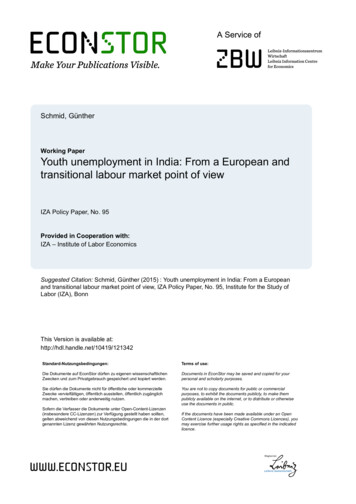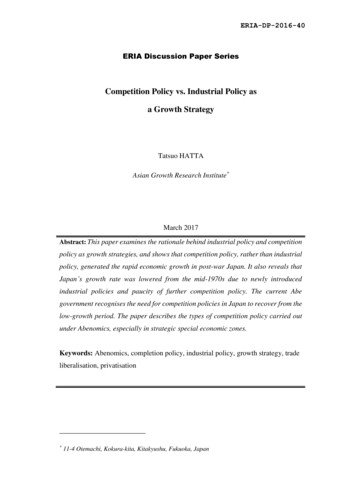
Transcription
Schmid, GüntherWorking PaperYouth unemployment in India: From a European andtransitional labour market point of viewIZA Policy Paper, No. 95Provided in Cooperation with:IZA – Institute of Labor EconomicsSuggested Citation: Schmid, Günther (2015) : Youth unemployment in India: From a Europeanand transitional labour market point of view, IZA Policy Paper, No. 95, Institute for the Study ofLabor (IZA), BonnThis Version is available ungsbedingungen:Terms of use:Die Dokumente auf EconStor dürfen zu eigenen wissenschaftlichenZwecken und zum Privatgebrauch gespeichert und kopiert werden.Documents in EconStor may be saved and copied for yourpersonal and scholarly purposes.Sie dürfen die Dokumente nicht für öffentliche oder kommerzielleZwecke vervielfältigen, öffentlich ausstellen, öffentlich zugänglichmachen, vertreiben oder anderweitig nutzen.You are not to copy documents for public or commercialpurposes, to exhibit the documents publicly, to make thempublicly available on the internet, or to distribute or otherwiseuse the documents in public.Sofern die Verfasser die Dokumente unter Open-Content-Lizenzen(insbesondere CC-Lizenzen) zur Verfügung gestellt haben sollten,gelten abweichend von diesen Nutzungsbedingungen die in der dortgenannten Lizenz gewährten Nutzungsrechte.If the documents have been made available under an OpenContent Licence (especially Creative Commons Licences), youmay exercise further usage rights as specified in the indicatedlicence.
PO LI CY PAPE R S E R I E SIZA Policy Paper No. 95Youth Unemployment in India: From a European andTransitional Labour Market Point of ViewGünther SchmidJanuary 2015Forschungsinstitutzur Zukunft der ArbeitInstitute for the Studyof Labor
Youth Unemployment in India:From a European and TransitionalLabour Market Point of ViewGünther SchmidBerlin Social Science Centre (WZB)and IZAPolicy Paper No. 95January 2015IZAP.O. Box 724053072 BonnGermanyPhone: 49-228-3894-0Fax: 49-228-3894-180E-mail: iza@iza.orgThe IZA Policy Paper Series publishes work by IZA staff and network members with immediaterelevance for policymakers. Any opinions and views on policy expressed are those of the author(s)and not necessarily those of IZA.The papers often represent preliminary work and are circulated to encourage discussion. Citation ofsuch a paper should account for its provisional character. A revised version may be available directlyfrom the corresponding author.
IZA Policy Paper No. 95January 2015ABSTRACTYouth Unemployment in India:From a European and Transitional Labour Market Point of View 1This essay first sketches some descriptive material, setting the stage and demonstrating thehighly differentiated statistical landscape of various measures for youth unemployment inEurope compared to India and in particular to Germany. Second, it provides a simple butpowerful model for the main causes of youth unemployment from which general policystrategies can be derived and illustrated by good practice examples from Europe, inparticular Germany. Third, because a large part of the problem is structural, requiring longterm solutions, possible immediate measures to mitigate the severe long-term scar effects forthe unemployed youth are briefly reviewed. Large differences of unemployment performanceamong European countries reveal, for instance, the importance of automatic stabilisers likeunemployment insurance in order to counteract the tendency of market economies to putmost of the burden of adjustment in times of recession on youth. The fourth and main part,however, is devoted to possible lessons for India from Europe, in particular from countrieswith low youth unemployment like Austria, Denmark, Germany and the Netherlands. Thetheoretical framework for these lessons is taken from the concept of Transitional LabourMarkets (TLM) which emphasises dual learning systems as an institutional device both forfair intergenerational risk sharing as well as for smooth transitions from school to work.JEL Classification:Keywords:E24, I24, J64youth unemployment, education, vocational training, labour market policy,transitional labour markets, risk sharingCorresponding author:Günther SchmidBerlin Social Science Centre (WZB)Reichpietschufer 50D-10785 BerlinGermanyE-mail: guenther.schmid@wzb.eu1Paper prepared for the International Conference “Jobs for Development: Challenges and Solutions”organised by the World Bank Group and the Indian Council for Research on International EconomicRelations (ICRIER), New Delhi, 1–2 December 2014. I am very grateful to Jackie O’Reilly forencouraging comments, to Jutta Höhne for assistance in organising Figures 1A and 2A, to ChristianBrzinsky-Fay for allowing using the Figures 4A, 5A, and 6A, and to Jennifer Rontganger for editorialhelp.
Youth Unemployment in India:From a European and Transitional Labour Market Point of ViewGünther SchmidIntroductionYouth unemployment seems to be quite moderate in many Asian countries byconventional statistics, particularly in South Korea, but also in India. Germany, with acurrent youth unemployment rate of 7.7 percent, is one of the very few European countriesoutperforming India. Certainly, these figures are hardly comparable, not least due to thelarge informal sector in India, and agriculture plays only a minor role in most Europeancountries. Nevertheless, the Indian case is in at least three other respects different fromEurope, in particular from Germany. From the perspective of intergenerational risksharing, India’s youth unemployment rate is three to four times higher than theunemployment rate of adults in their core age; in Germany, this figure is below two. Inaddition, educated youth in India face a higher risk of unemployment than the loweducated, whereas in Europe it is the other way round. A further peculiarity can be seenwhen unemployment is measured by the number of youth not in employment, education ortraining (NEET) as a percent of the total youth population. India’s NEET rate,approximately 28 percent, is at the top of the G20 countries, whereas the German NEETrate corresponds to its unemployment rate.This essay intends to shed some light on this conundrum: It first sketches some descriptivematerial, setting the stage and demonstrating the highly differentiated statistical landscapeof various measures for youth unemployment in Europe compared to India and inparticular to Germany. Second, it provides a simple but powerful model for the maincauses of youth unemployment and for related general policy strategies illustrated by goodpractice examples from Europe, in particular Germany. Third, because a large part of theproblem is structural, requiring long-term solutions, possible immediate measures tomitigate the severe long-term scar effects for unemployed youth are also briefly reviewed.2
Large differences of unemployment performance among European countries, for instance,reveal the importance of automatic stabilisers like unemployment insurance in order tocounteract the tendency of market economies to put most of the burden of adjustment intimes of recession on youth.The main part of this essay, however, is devoted to possible lessons for India from Europe,in particular from countries with low youth unemployment like Austria, Denmark,Germany and the Netherlands. The theoretical framework for these lessons is taken fromthe concept of Transitional Labour Markets (TLM) which emphasises dual education andvocational training systems as an institutional device both for fairer intergenerational risksharing as well as for a smoother transition from school to work.1.Setting the stage: Youth unemployment in Europe, Germany and IndiaYouth unemployment seems to be quite moderate in India: Conventionally measured as apercentage of the corresponding ‘active’ labour force, youth unemployment was onlyabout 11 percent in 2011/12 compared to about 23 percent on average in the EuropeanMember States (EU-28) at the time of writing (October 2014). Germany, with a currentyouth unemployment rate below 8 percent, is one of the very few European countriesoutperforming India in this respect (Table 1, line 1). 2The Netherlands, Austria and Switzerland are the other European countries with moderateyouth unemployment rates. On the other hand, there are EU member states with incrediblyhigh levels of youth unemployment, lifting the overall average level in Europe: InNovember 2013, the Mediterranean countries Greece and Spain had levels of around 55percent, and Portugal, Italy and Croatia had levels between 35 and 50 percent. TheGerman case, however, has not always been so exceptional particularly if we look backprior to the recession. Its current ‘comfortable’ level of youth unemployment reflects tosome extent the recent ‘German job miracle’ (Biavaschi et al. 2012, Eichhorst 2012, Rinneand Zimmermann 2013), and to some extent various flexibility buffers that helped2For more detailed information see Table 1A and Figures 1A-6A in Appendix.3
overcome the last recession with only a minor impact on overall unemployment and towhich we shall come back later in this paper. Nevertheless, compared to most otherEuropean countries, Germany seems to have youth unemployment largely under control.Table 1:Youth unemployment indicators: India compared to Europe (EU-27/28)and Germany, in percentINDIAEUROPEGERMANYYouth Unemployment Rate(Unemployed youth 15–24as percent of active youth labour force) 1123.27.7 2813.27.7 1.8 1.0 0.9 3.32.51.6 16 2318.83.9 3 231.011.4n.a.9.84.0Youth NEET Rate(Youth 15–24 not in employment, educationor training as percent of youth population)Youth U Rate Women/Men(for India: urban areas)Youth U Rate/Adult U Rate(Youth U Rate 15–24 divided by Adult URate 25-74)Youth U Rate High Educated(for India: Men Urban)(for India: Female Urban)Youth U Rate Low Educated(for India: Men Urban)(for India: Female Urban)Youth Unemployment Ratio(Unemployed Youth 15–24 as percent ofyouth population aged 15–24)Source: NSSO (2014:192), OECD/ILO (2014:6), OECD (2014), own calculations. Data for India refer to theyears 2011/12, except NEET (2009/10); data for Europe and Germany represent most recent availablefigures (2013/14) or 2012 (NEET).However, the Indian case is in at least four respects different from Europe and Germany.First, the conventional measure of youth unemployment has serious flaws which lead to alot of confusion. First of all, it does not consider that an increasing number of youngpeople enter and stay in education (secondary or full-time vocational schools oruniversities); in other words, they are not available to the labour market and do not belongto the “active labour force”. Moreover, the conventional measure of youth unemploymentdoes not consider that many young people become discouraged and withdraw from the4
‘active’ labour force. 3 Youth unemployment measured in NEET and related to the totalyouth population takes a broader spectrum of jobless people into account, relating it to thetotal youth population: Youth neither in employment nor in education or training as apercentage of the total youth population is much higher in India by an approximatemeasure delivered by OECD/ILO (2014); it is in the range of 28 percent compared to 13.2percent in Europe and only 7.7 percent in Germany (Table 1, line 2).Second, young women in India face a higher risk of unemployment than men, in particularin urban areas, whereas in most European countries young women have – in contrast toformer times – lower unemployment rates than men, particularly in Germany (Table 1,line 3).Third, from the perspective of intergenerational risk sharing India’s youth unemploymentrate is about three to four times higher than the unemployment rate of adults; in Europe,this figure is on average 2.5, and in Germany only 1.6 (Table 1, line 4).The fourth spectacular difference is the fact that educated youth in India face a muchhigher risk of unemployment than the low educated, whereas in Europe, and in particularin Germany it is the other way round. The unemployment rate of high-educated(“graduated & above”) young Indian women in urban areas is 23 percent in contrast toonly 2 percent of low-educated (“literate and up to primary level”) young women (Table1, lines 5 and 6). In Europe, the unemployment risk of highly educated youth is on averageonly about half of the unemployment risk of low-skilled, and in Germany it is even lessthan a third (3.9 percent vs. 11.4 percent). This educational gap still holds true if we lookat the whole youth cohort aged 15 to 29 in terms of NEET rates in OECD countries: Theonly countries where high-educated youth face a considerable higher NEET rate than loweducated youth are Iceland, Japan, Korea and Greece (see Figure 3A, Appendix).3The European media, for instance, often mistakenly report that more than half of the Greek or Spanishyouth (over 50% or one of two) are unemployed. This is correct related to the baseline of the “active youthlabour force” (the employed and unemployed youth); but it is wrong measured in relation to the whole youthpopulation. In 2013, the youth unemployment ratio (unemployed youth as a percentage of the populationaged 15–24) was “only” 16.6% in Greece (i.e. one of six), and “only” 9.8% in EU-28 or 4% in Germany(Table 1, line 7).5
To sum up: Despite a relatively moderate level of youth unemployment by conventionalmeasures, like most European countries, India has a serious youth unemployment problemand this problem seems to be particularly related to those youth with an academiceducation, whereas Germany, too, obviously has a youth unemployment problem which,however, is mainly related to a low-educational status. Furthermore, like many otherEuropean countries, India faces a paradoxical situation where, on the one hand, youth arelooking for jobs and on the other hand industry is suffering from the lack of skilledworkers, a skill mismatch that makes youth unemployable (Sanghi and Srija 2014).In the following, I will shed some light on these questions: What are the main causes ofyouth unemployment and which policy strategies in general could contribute to solvingthis problem? What kind of policy measures could immediately be taken to avoid longterm scar effects for unemployed youth? What lessons (and which not) might India learnfrom Europe, in particular from Germany? In the outlook I come back to the puzzle ofhighly and academically inflated youth unemployment which seems to be quite commonin Asia, in particular in South Korea, but also to some extent in India, by referring to apossible hidden cause: A strong insurance motive might explain the low status of middlelevel vocational training and the overall striving for an academic degree.2. Main causes of youth unemployment and possible policy strategiesThe issue of youth unemployment is certainly complex, but – as Nobel Prize winnerRobert Solow once said – “fine distinctions make bad policy”. So, a simple but powerfulcausal framework with corresponding policy strategies might look like the followingFigure (Figure 1).6
Figure 1:Youth Unemployment: A Simple Causal Framework and Possible PolicyStrategiesYouth needs more andbetter jobsYouth needs the right skillsYouth needs goodgovernancesupport job creation,complemented by sensiblejob maintenance, flexiblejobs and work sharingraise learning capacities,complemented by duallearning systems thatcombine learning withworking and earningfoster cooperative industrialrelations, fair risk sharing,ensure quality standards,fight against discriminationYouth unemployment has three main causes, and all three may be interconnected: First, it is the lack of jobs due to economic slumps, low public or private investment orlow international competitiveness. So, first of all, youth needs more and better jobs.The main strategies related to this challenge are the public support of job creation atvarious levels, of sensible job maintenance, flexible jobs and work sharing. The second cause might be the mismatch between skills demanded by existing jobsand skills provided by the educational system. So, youth need better skills. The mainstrategies related to this challenge are two: Because one never knows exactly whatspecific skills are needed in the future, the first strategy is to raise learning capacities,in particular through general and higher education. But (young) people also have toearn a living; so to some extent these skills have to be related to the labour market, forinstance, through dual education systems that combine learning with working andearning.7
The third cause might be labour market rigidities that prevent or slow down thenecessary adjustment to changing technologies, to changing needs or preferencesrelated to goods and services, or to changing terms of trade due to internationalisationor globalisation. So, youth need good governance. The main strategies related to thischallenge are cooperative industrial relations that allow flexible wages and moderateemployment protection, fair risk sharing through reasonable social protection, andnon-discriminated access to all jobs, and the assurance of high-quality standards ofworking conditions.In the following I can only briefly sketch the main points related to these strategies basedon a quite selective review of the literature; the discussion of corresponding policyinterventions also touches only superficially on the main strategic lines without going intoa deeper debate.2.1Youth need more and better jobsWhat are the reasons for the lack of jobs for young people? These reasons may be cyclicalor structural. First, markets are strong in innovation and competitiveness, but they alsotend to speculative investment instead of real investments. The last recession in Europeprovides a good example: Those countries that experienced the largest increase in youthunemployment 4 had sharp declines in house prices during the Great Recession, suggestinga direct link to the youth labour market because a disproportionate number of the youngmen working in construction who particularly suffered from the effects of property pricebubbles (Bell and Blanchflower 2011). Second, recessions clearly disadvantage youththrough the “last in first out” rule; youth are therefore the most vulnerable group ineconomic slumps when demand collapses: They are the first to be dismissed andcompanies close their doors to recruitments first for the young without work experience(e.g. Kawaguchi and Murao 2012). Third, markets tend towards excessive wagevolatilities and inequalities leading to in-work poverty; fourth, they also tend towardsinvestments in the most profitable sectors neglecting public goods and infrastructure.4For example: Estonia ( 20.7 percentage points), Ireland ( 18.4), Latvia ( 23.2), Lithuania ( 26.1) andSpain ( 21.6) from the beginning of 2008 to the third quarter of 2010.8
These four main reasons for the lack of jobs may also be taken to structure the followingbrief sketch of promising policy strategies.(1) The first strategy relates to the cyclical lack of jobs, which was aggravated during thelast recession through the fiscal and financial crisis. A recent study by the IMF (2014)found that cyclical factors explain around 50 percent of the changes in European youthunemployment rates and even 70 percent of the increase in unemployment rates in stressedEuro area countries. The sensitivity of unemployment rates to the business cycle (Okun’scoefficient), however, varies across countries. Estimates range from not significantlydifferent to zero (e.g. Austria) to -1.9 in Spain, i.e. a 1 percent decline in growth increasesyouth unemployment rates by almost 2 percentage points. Countries with the biggestincreases in youth unemployment rates since the crisis tend to be those that are mostaffected by the business cycle (i.e., they have the highest Okun’s coefficients); and inevery country the estimated Okun’s coefficient is higher for youth than for adults, onaverage almost three times as large.What follows from this observation should be quite clear: Governments can help mitigatethe detrimental impact of recessions on youth (Okun’s coefficient) through deficitspending in the slump and savings in the boom. However, although such Keynesianinstruments certainly have some value, they are limited due to well-known state failure:Politicians like to spend but not to save; short-term investments are often misplaced(recall, e.g., some spectacular building of bridges without connections in Japan), and goodinvestments take time to develop their bite on unemployment.A more sustainable policy strategy for governments is to bind themselves to the mast ofthe ship like Ulysses against the Sirens in Greek mythology, which means to resisttempting but dangerous policies and to build instead automatic stabilisers into the system:For instance, unemployment insurance which maintains effective demand during thecrisis; short-time work allowance which prevents unemployment through risk sharingamong workers, employers and the state during a crisis; health insurance for allindependent of having or not having a job; reliable basic pensions independent from theindividual work-life career which is often determined by pure luck. All these automatic9
stabilisers maintain not only consumer demand in times of crisis but also their trust in theeconomic recovery. European research shows that countries with such automaticstabilisers perform best and have kept youth unemployment within reasonable limits(Dolls et al. 2011).However, such automatic stabilisers cannot be established overnight; they need long-terminvestments. A more short-term possibility is to allocate resources for special youthmeasures in the framework of active labour market policy (ALMP) in an anticyclical way.The essential instruments of ALMP are matching services, training and (carefullytargeted) subsidised employment. European research shows that – on average – increasingALMP expenditure per unemployed worker by 1 percentage point of GDP per member ofthe labour force lowers the overall youth NEET risk by 0.15 percentage points (EuropeanFoundation 2012). Switzerland (with relatively low youth unemployment) is one of thefew countries to have established an anticyclical expenditure rule for active labour marketpolicy (Duell et al. 2010).(2) Second, regarding structural reasons for the lack of jobs, the first thing governmentsshould do is get the financial market under control. Sustainable growth is only possible ifproductivity gains are continuously channelled into innovation and investments instead ofrisky speculation. 5 The respective proper policy strategy is to support sustainablecompetitiveness by setting the right institutional framework conditions for innovativeprivate investment, e.g. through regulating the banking sector and through thederegulation of product market monopolies. Furthermore, targeted industrial policy helpsto create new jobs, e.g. by fostering green technologies or information and communicationtechnologies. If unemployment is regionally quite different – as is the case both in Europeand India – such incentives might be combined with a regional component. Sinceindustrial investments are globally interdependent, some regional and internationalcoordination of growth strategies is necessary. 65This complex issue would require more attention but goes beyond my expertise and the range of this paper;see among many others Hellwig and Admati (2013).6This holds especially true for the still nationally fragmented Eurozone; see for the need of creating an“adequate fiscal capacity” in the Eurozone, e.g. Alberto Majocchi (2013).10
Examples of what happens if governments are not investing enough in competitivetechnologies can be observed in some European countries like Spain and Greece, whereyouth unemployment now exceeds (conventionally measured) 50 percent. France with ayouth unemployment rate of 25 percent is another illustrative case. Its lack ofcompetitiveness is, for instance, reflected in the drastic decline of jobs in industrialmanufacturing. In 2000 France still had 20 percent of jobs in manufacturing which fell toonly 12.5 percent in 2011; in Germany, the share of manufacturing jobs even increased to26.2 percent during this time.Other framework conditions are a broadly skilled, middle-level workforce of craftsmenand engineers maintained through an extensive apprenticeship system (see 2.2 below). TheEuropean case may also suggest that the focus of industrial policy should be directedtowards small- and medium-sized companies, in Germany called the “Mittelstand”. Thisdevice already seems to have been acknowledged in India. In its annual budget report, theIndian Finance Ministry says that “too many small firms stay small and unproductive andare not allowed to die gracefully”. According to the World Bank, insolvency processestake on average 7.9 years and cost 8.6 percent of the estate value. The real challenge,however, is to be able to not just start up, but to continue to grow, thereby becoming asource of sustainable jobs and value creation. Moreover, too many large profitable firmsprefer to rely on temporary contract labour than on training workers for longer-term jobs(Ministry of Finance 2013: 36–8).Certainly, the German model cannot be copied by India, and it should not be copied, notleast due to its own flaws (see below). It is therefore hard for a European outsider to givespecific advice in this respect. Only an emphasis on general principles might make sense.One of these principles, the European case seems to teach, is that a healthy economy needsa hard core of competitive industrial manufacturing. 7 Of course, the decline ofemployment in industrial manufacturing due to its productivity dynamics can becompensated to some extent by intelligent services. But these service jobs should not berestricted to luxury articles like the French brand names Louis Vuitton, Hermès and Yves7In sharp contrast to China in the last 20 years, growth in India was not driven by manufacturing but byservices, however mainly by services with low job intensity (Drèze and Sen 2013: 31).11
Saint-Laurent. A competitive service industry must be related to mass markets likefinancial or insurance services, information and communication technologies, andeducation or health services. An increasing part of those services provide essential inputsfor a modern industrial manufacturing. Another general principle is the slowtransformation of the (huge) Indian informal sector into a formal sector through intelligentinstitutional devices. 8 One step in this direction would be to establish basic incomeguarantees for workers hit by insolvencies, a device that would allow unproductive firmsto die ‘gracefully’ without causing high social costs.(3) A third important framework condition for job creation is wage moderation. SomeEuropean countries with high and rising youth unemployment (in particular France, Italy,Greece and Ireland) had previously endured unit wage costs exceeding productivitygrowth or high minimum wages that made employers reluctant to hire youth. Of course,wages should not fall below a decent minimum standard, which might be a reason forpolicy intervention in favour of a minimum income guarantee. And despite moderatewages it might still be difficult for some SME to shoulder the wage costs so that carefullytargeted wage subsidies, in particular for young people, might make sense (see 3.5 below).Germany can only partly serve as a model here: First, related to young people the Germancase is particular due to its apprenticeship system which ensures low-entry wages; second,Germany’s moderate wage policy goes back to its tried and tested cooperative relationshipbetween trade unions and employers’ associations, a social partnership protected andsupported by the government; both structural features cannot easily be copied (see 2.3below).(4) The fourth policy strategy is public job creation particularly in areas where the marketusually does not invest due to lack of profitability which goes back to the non-rival ornon-exclusive character of some goods and services. 9 Although a clear-cut distinction8The budget report of the Ministry of Finance (2013: 47) acknowledges this principle: “India’s high rate ofinformality is a drag on its economic development and a source of considerable inequity. Productivitydifferences between workers in the formal and informal sectors are large [.], suggesting that moving aworker from an informal to a formal firm would bring about sizeable gains from improved allocation ofresources.”9For a good theoretical discussion of public vs. private goods see Adams and McCormick (1993).12
between public and private goods or services is not possible, chronic underinvestment inpublic goods like traffic infrastructure, education, health and care services has been provenby many studies to be chronic. Furthermore, as jobs in agriculture and industrialmanufacturing are in secular decline, service jobs are the most likely future entry into thelife or work for young people, independent of whether they are created by the market orthe state. For India, Drèze and Sen (2013: 33) deplore in particular the lack of progress inpublic services as a huge barrier to improving the quality of life.So, there is a wide range of possible productive policy interventions, not least – and thatsounds like a paradox – by strengthening market principles, for instance, opening access tomarkets for small- and medium-sized enterprises by fighting all kinds of monopolies or byensuring that young people are allocated to jobs by their competence and not by theirformal educational status (credentialism). This leads to the next policy strategy againstyouth unemployment.2.2Youth need the right skillsThe main reasons for the lack of skill or for misguided skills are simple: Too lowinvestment in ‘human capital’; asymmetric investment l
unemployment insurance in order to counteract the tendency of market economies to put most of the burden of adjustment in times of recession on youth. The fourth and main part, however, is devoted to possible lessons for India from Europe, in particular from countries with low youth unemployment like Austria, Denmark, Germany and the Netherlands.










